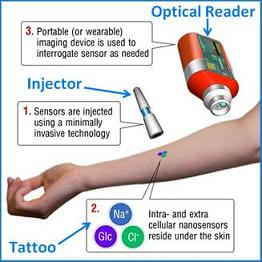Nanotechnology ‘Tattoos’ To Help Diabetics Track Glucose Levels

Share
Scientists are developing special tattoos which may allow those with diabetes to more accurately and quickly monitor their glucose levels. Two different research teams, led by Michael Strano at MIT and Heather Clark at Draper Labs, have developed two different types of nanotech 'ink' which would be injected in the skin and change fluorescence depending on your blood sugar. Both types of tattoo would require an external device to measure and translate this fluorescence. While still in the very early stages of development, these glucose tattoos could one day improve the lives of diabetics by giving themselves a built-in monitor for their condition. Robotics and genetics may provide the near term revolution in healthcare but this work shows that embedded nanotechnology has the potential to create even larger innovations thereafter.
According to the WHO, diabetes affects more than 170 million people worldwide today, with projections of 360+ million by 2030. While ideally we want to prevent these cases, we're going to need better monitoring and treatments for those that develop the condition. Embedded electrical monitors and glucose pumps already help diabetics manage their blood sugar level today, but improved accuracy and ease of reading would increase compliance and improve patient health. While we've seen an attempt to put glucose monitors in contact lenses, the tattoo approach would provide a subtler but possibly clearer way to keep diabetes in check.
While both MIT and Draper Labs are both pursuing a skin-borne diabetes monitor, their approaches have very different merits. Strano's Group at MIT is using single walled nano-tubes (SWNT), a standard in nanotechnology. The SWNT's are embedded in a hydrogel placed under the skin. Changes in blood glucose cause the hydrogel to swell, which in turn effects the fluorescence of the SWNTs in near infrared light. A wristwatch-like device would be worn over the SWNTs in the skin and used to monitor the SWNTs and thus the blood glucose level. Because SWNTs don't break down as they fluoresce, you can continually monitor them. That constant readout of a patient's blood sugar levels should improve the way they control their condition. Strano's group thinks that the hydrogel/SWNT tattoo might last around six months. As described in their publication in ACS Nano from late last year, the MIT team has tested the SWNT system in mouse tissues and seen good signal strength for the detector.
Draper Lab's glucose tattoo works by modifying a detector platform they have in development. Clark and colleagues have nano-sized polymer beads with special chemicals trapped inside. Glucose is pulled into the bead and causes a chemical reaction that produces fluorescence. A handheld or wearable monitor (reportedly in development) would be able to see that fluorescence and translate it into a glucose reading. The Draper team published in Analytical Chemistry in March and described early success with their nano-bead system in living mice. Unlike MIT, Draper only plans on placing their nano-tattoo in the upper layers of the skin, so it would only last about a week. As such, they plan on developing an easy injection system patient's would be able to use themselves. You can see an animation, narrated by Clark, in the video below. Unfortunately, the audio quality is very poor, so you may want to see Clark's entire interview on the Draper site.
Be Part of the Future
Sign up to receive top stories about groundbreaking technologies and visionary thinkers from SingularityHub.


Each approach to a diabetes tattoo has its own advantages. MIT is aiming for a longer lasting detection system that would absolutely be able to handle round the clock monitoring. Draper is going for a more "temporary tattoo" approach. Draper's nano-bead system, however, is adaptable to other particles besides glucose, such as important ions in the blood. This may make it the more versatile and applicable platform. The difference in publication dates and level of animal models used (in vitro and in vivo) makes it hard to see which team is nearer to creating a working system. Let's just say they're neck and neck...with years and years left to go in the race. Human trials are a long ways off for either team.
Improved monitoring systems are going to lead to better glucose regulation (through diet or insulin) and better health. These technologies are also just part of the leading edge of nano-scaled devices which are making their way into our bodies. One hopes that nanotech glucose monitors will be followed by nanotech glucose pumps (to correct bad blood sugar levels). Eventually we may even see nano-devices which provide non-diabetics with optimal glucose levels for improved performance. In other words, first you get the monitoring, then you get the correcting, and then you get the augmenting. Blood sugar is only one of the possibilities. Toxins, oxygen levels, hormones - our bodies may one day be filled with nanotechnology regulating all of them. Regular tattoos may make you look stronger, but this next generation will actually make you stronger. Sign me up.
[image credits: MIT News/Christine Daniloff, Draper Labs]
[video credit: Draper Labs]
[source: ACS Nano, Analytical Chemistry, MIT News, Draper Labs]
Related Articles

Single Injection Transforms the Immune System Into a Cancer-Killing Machine

This Light-Powered AI Chip Is 100x Faster Than a Top Nvidia GPU

This Week’s Awesome Tech Stories From Around the Web (Through December 20)
What we’re reading

